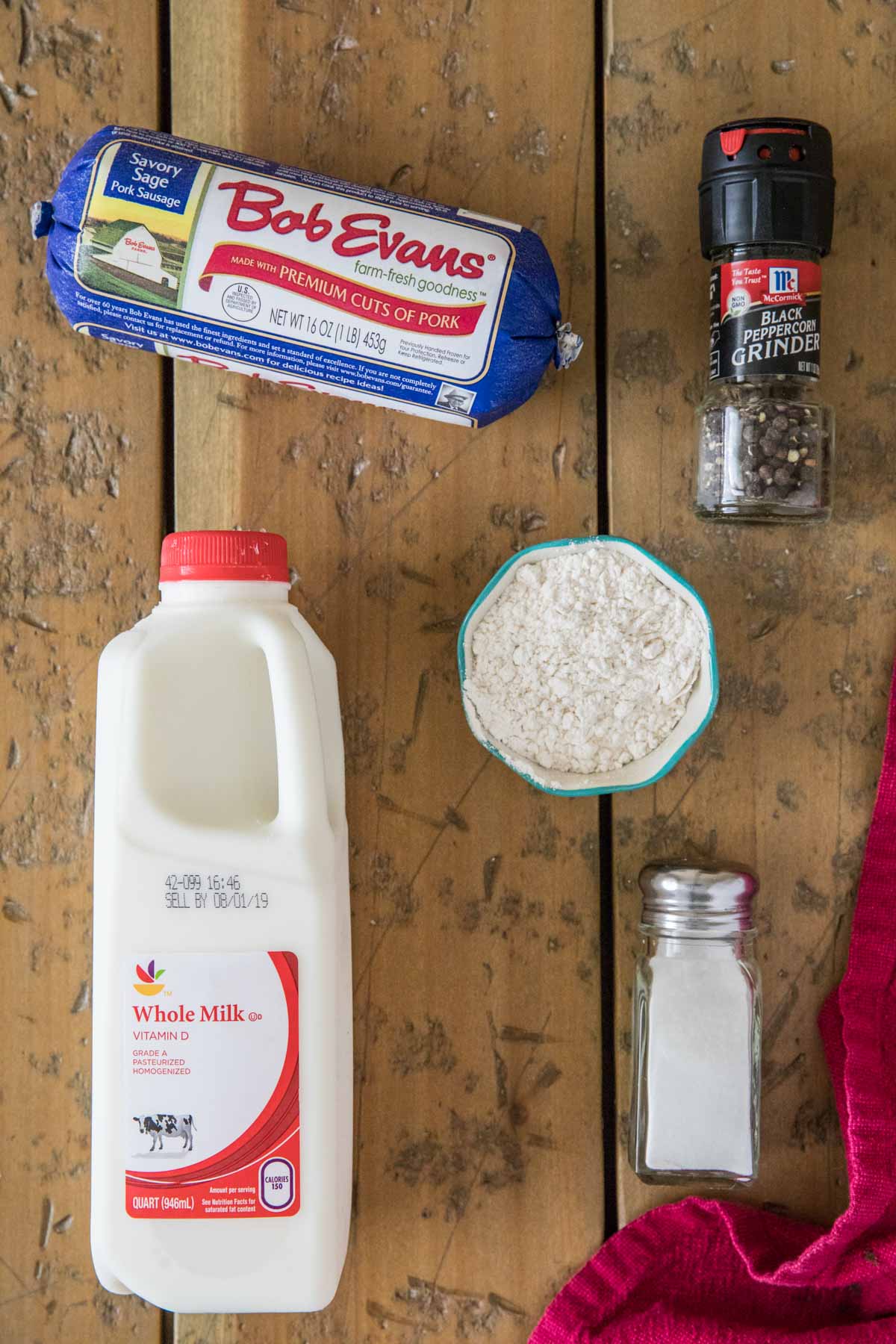This is my old-fashioned recipe for homemade sausage gravy, which is also called “sawmill gravy.” It only takes 4 ingredients and 15 minutes to make this great breakfast food. Pairs perfectly with my 5-star foolproof homemade biscuits!.
If you love biscuits and gravy, you know that the key to great sausage gravy is finding the perfect balance of flour and milk. Too little flour and your gravy is runny and thin. Too much flour and it’s pasty and gloppy. And if you don’t add enough milk, the gravy can be dry and taste overly floury.
So how do you know exactly how much flour and milk to use for smooth, velvety sausage gravy every time? In this article, I’ll share my tips and tricks for nailing the flour-to-milk ratio so you can make restaurant-quality sausage gravy at home.
How Flour and Milk Work Together in Sausage Gravy
First, let’s look at the role flour and milk play in sausage gravy:
-
Flour – When you cook flour in the rendered sausage fat, it forms a roux that thickens the gravy so it nicely coats the back of a spoon. The flour gives the gravy its rich, velvety texture.
-
Milk – The milk adds moisture and creaminess to balance out the roux. It also helps carry the flavor of the sausage throughout the gravy. Too little milk and the gravy will be pasty, but too much makes it thin and watery.
The key is to use just enough flour to reach the desired thickness, while adding enough milk for a smooth, creamy consistency. It takes some finesse, but follow my tips below and you’ll be a sausage gravy expert in no time!
How Much Flour Do You Need for Sausage Gravy?
For a medium thickness gravy, the classic ratio is:
- 1 tablespoon flour per 1 tablespoon fat/drippings from the sausage
So if you use 1/2 pound of sausage (yielding around 2 tablespoons of fat), you’ll need 2 tablespoons of flour. For a full 1 pound of sausage (about 4 tablespoons of fat), use 4 tablespoons or 1/4 cup flour.
This 1:1 flour to fat ratio gives you a nice gravy that coats the back of a spoon without being too thick. But you can tweak the ratio depending on how you like your gravy:
- Thin gravy – Use 1 1/2 teaspoons flour per 1 tablespoon fat
- Thick, scoopable gravy – Use 2 tablespoons flour per 1 tablespoon fat
When in doubt, start with less flour. You can always stir in more at the end to thicken up the gravy if needed.
How Much Milk Should You Add to Sausage Gravy?
When it comes to the milk, you’ll need to eyeball it instead of measuring exactly. Here are some tips:
-
Start with 2 cups milk for a 1/4 cup roux. Slowly whisk in the milk until fully incorporated.
-
Gradually add more milk until you reach the desired consistency. For a medium gravy, you’ll need around 2 1/2 to 3 cups total.
-
Go slowly – it’s easier to thin out thick gravy than vice versa. Add milk 1/4 cup at a time, allowing the roux to absorb before adding more.
-
Whole milk is best, since lower fat milk can make the gravy thinner. But you can use 2% milk if needed.
-
Warm the milk slightly to prevent lumps from forming when adding to the hot roux.
Be patient and add milk gradually for the perfect gravy texture every time.
Step-by-Step Instructions for Perfect Flour-to-Milk Ratio
Follow these simple steps for smooth, velvety sausage gravy:
1. Cook sausage – Brown 1 lb breakfast sausage over medium-high heat until crumbled and cooked through, 5-7 minutes. Drain excess grease, leaving just the drippings.
2. Make roux – For 1 lb sausage, sprinkle 1/4 cup flour over drippings. Cook 2 minutes, stirring constantly.
3. Slowly whisk in milk – Start by adding 2 cups whole milk, whisking constantly to prevent lumps.
4. Gradually add more milk – Continue adding milk 1/4 cup at a time until gravy coats back of spoon and is the desired consistency. For a medium gravy, you’ll need 2 1/2 to 3 cups milk total.
5. Cook until thickened – Let gravy simmer 2-3 minutes to fully thicken.
6. Season and serve – Add salt, pepper, garlic powder if desired. Serve over hot biscuits!
The flour-to-fat roux ratio gives the base thickness, while the milk provides the ideal creamy texture. Master this technique and you’ll have perfect gravy every morning!
Troubleshooting Common Sausage Gravy Issues
Here are some tips if your gravy texture isn’t quite right:
-
Too thin – Whisk in a bit more flour until it reaches the desired thickness
-
Too thick – Gradually stir in more milk until the gravy is smooth and coatable
-
Lumpy – Use a whisk to vigorously beat out any flour lumps
-
Greasy – Try adding a bit more flour to soak up excess fat
-
Bland – Season with more salt, pepper, herbs, and spices to amp up the flavor
-
Scrappy texture – For smoother gravy, blend it with an immersion blender
With the right ratio of flour and milk, you can troubleshoot any gravy texture issues. Just remember – you can always thin it or thicken it up!
Handy Substitutions for Flour and Milk
While all-purpose flour and whole milk are ideal for gravy, you can use some substitutions in a pinch:
-
Flour – Gluten-free flour blend, cornstarch, arrowroot. May need more to thicken.
-
Milk – 2% milk, half and half, heavy cream, unsweetened non-dairy milk like almond or soy milk.
-
Sausage – Vegetarian sausage, ground turkey or chicken leg and thigh meat.
The recipe may need slight adjustments with substitutions to get the perfect texture. But you can adapt it to suit various diets and ingredients.
More Delicious Ways to Enjoy Sausage Gravy
Once you’ve mastered basic sausage gravy, get creative with these flavorful variations:
-
Cheddar sausage gravy – Stir in shredded cheddar for a cheesy twist
-
Chicken sausage gravy – Use spicy chicken sausage for a lighter version
-
Creamy sage gravy – Add fresh or dried sage for extra flavor
-
Loaded sausage gravy – Sauté onions, peppers, mushrooms and mix in
-
Chorizo gravy – Use spicy chorizo sausage for a Tex-Mex kick
-
Bacon sausage gravy – Cook chopped bacon first for a smoky flavor
-
Biscuits and gravy breakfast casserole – Layer biscuit dough and gravy then bake
-
Chicken fried steak with gravy – Top breaded pan-fried steak with creamy gravy
-
Sausage gravy poutine – Heap gravy over fries and cheese curds
The possibilities are endless once you know the basics of the flour-to-milk ratio! Enjoy your morning biscuits smothered in the perfect homemade sausage gravy.

k
Why You’ll Love This Recipe:
- Really easy to make—beginners
- Ready in under 15 minutes
- It’s a satisfying, filling, and hearty breakfast gravy
- True to life, you won’t find a sausage gravy this good anywhere, not even at your favorite breakfast spot.
Ingredients You’ll Need

Simple ingredients, spectacular results. Here’s what you need for my homemade sausage gravy recipe:
- Sausage. Look for pork breakfast sausage. It’s usually sold in a log shape, like the picture above. If you can find sage, add it to your gravy. It will make it taste even better.
- Flour. For this recipe, use all-purpose flour. It will thicken the gravy and keep it from getting too leaky. Some readers have said that using a 1:1 gluten-free flour instead of wheat flour worked well, but I haven’t tried it myself yet.
- Milk. Whole milk is best for the proper consistency. If you use low-fat milk, the sausage gravy will be thinner.
- Seasoning. To taste, add salt and pepper. If you want, you can also add a pinch of crushed red pepper. There may be something missing from the gravy’s flavor after it’s done cooking. You may just need a few more shakes of salt!
This is just an overview of the ingredients we’re using today. For the full list of amounts and all recipe details, please scroll down to the printable recipe.
5-Star Sausage Gravy with Ree Drummond | The Pioneer Woman | Food Network
FAQ
How many tablespoons of flour per cup of liquid for gravy?
What can I use to thicken my sausage gravy?
Can I use milk instead of heavy cream for gravy?
How do I make a creamy sausage gravy?
Milk – for a creamy sausage gravy, use milk to thin it out. Any type of milk will work, 2% or whole would be my preference. Garlic Powder, Salt, Pepper. These simple seasonings work well with just about anything. In this recipe, much of the flavor is coming from the sausage, so no fancy spices are needed. This recipe is really very simple.
Which milk is best for sausage gravy?
Whole milk is the best for this gravy recipe as it makes it nice and thick but if you must you can use any milk that you have (other than skim). But if you are going to go through the trouble of making the best gravy ever, you really need to go with the full fat milk for the best flavor. How to store leftover sausage gravy?
What can I add to sausage gravy?
You can use either ground pork breakfast sausage, spicy pork sausage, or Italian sausage. For heat, add a pinch of cayenne or crushed red pepper flakes. For added flavor, add 1/2 teaspoon each of garlic powder and onion powder. What do you serve with sausage gravy?
How long does it take to make sausage gravy?
This Classic Sausage Gravy recipe is creamy, peppery, made from scratch, and just the perfect comfort food! Made in just 20 minutes, and just great for slathering over some biscuits. This is one of my Breakfast recipes I know you’ll want to keep on hand! Pin this recipe for later!
